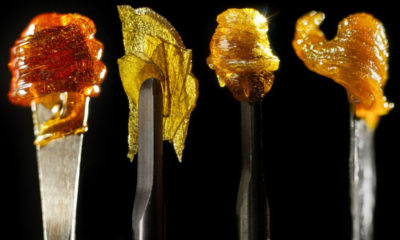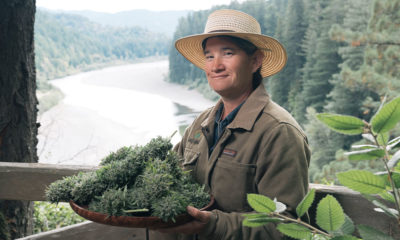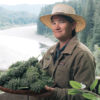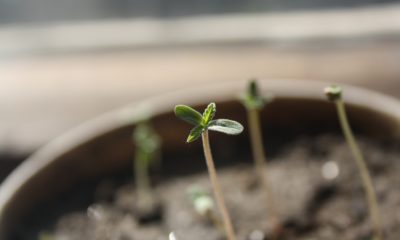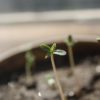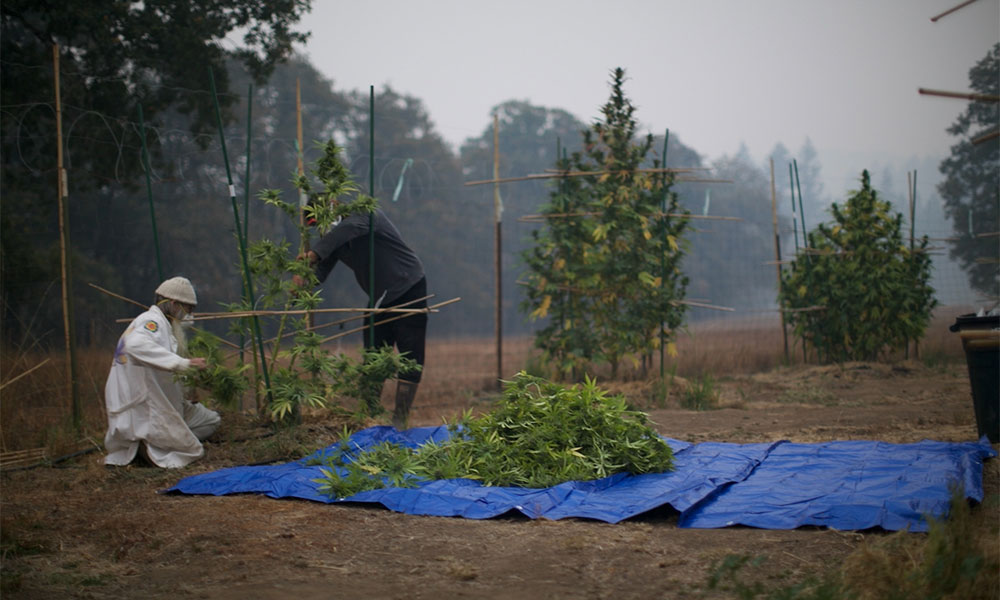
Cultivation
How to Harvest Sungrown Cannabis
Swami of the Emerald Triangle’s Swami Select shares his tried and true methodology for harvesting sungrown cannabis.
Up in the Mendocino Highlands, harvest typically starts in late September or early October, depending on the cultivar. Some girls want to come in early, and some may stretch it out until early November. Here at Swami Select, we had an Ethiopian Sativa one year that finished after Thanksgiving—not what you want because of the increased likelihood of fog, rain or frost that late in the season.
This is the tensest time of year, because there are still so many ways that you could lose some or all of the crop. In the old days, the paranoia was palpable as October arrived. While the crop ripened, every day that you waited to cut increased the chances of getting busted by the cops or being robbed by “marijuana rustlers.”
Potential Threats

We still need to be vigilant for other threats such as russet mites, aphids and latent hop syndrome. If the rains start in September, or the mornings bring heavy fog, mold and powdery mildew may develop. For the latter, foliar spraying with hydrogen peroxide can help, but the best preventative is spraying with a fermentation of horsetail starting in June.
Frost can also be a threat. The later into October and November the harvest extends, the more likely a heavy frost will hit, especially in mountain valleys. Most hardy plants can survive one early morning frost if it is only in the mid-twenties, but two or three frosts will kill many plants. Be prepared to cover each plant with frost cloth and they will survive.
These days in California and Oregon, outdoor crops face an additional threat from wildfires, which means you need to have an evacuation plan for your crew, plus a survival plan for the crop. An automated irrigation system will keep the girls alive if you need to bail.
If the crop gets dusted with white ash from the fires, use a leaf blower to blow it off the leaves and then spray with diluted hydrogen peroxide (H2O2). If the smoke at harvest is dense for days, after cutting and weighing each plant, dip each branch in dilute H2O2 and then dip in clean water; then hang to dry outside before bringing the branches into the drying room.
Yellow leafing the plants is paramount, and on the day before harvest, pull off most of the sun leaves from the plants you will take. As the days get shorter, keep cutting back on water, unless it’s super-hot, and stop feeding or using compost teas a week to ten days before harvest.
The Science (and Art) of Harvesting Cannabis
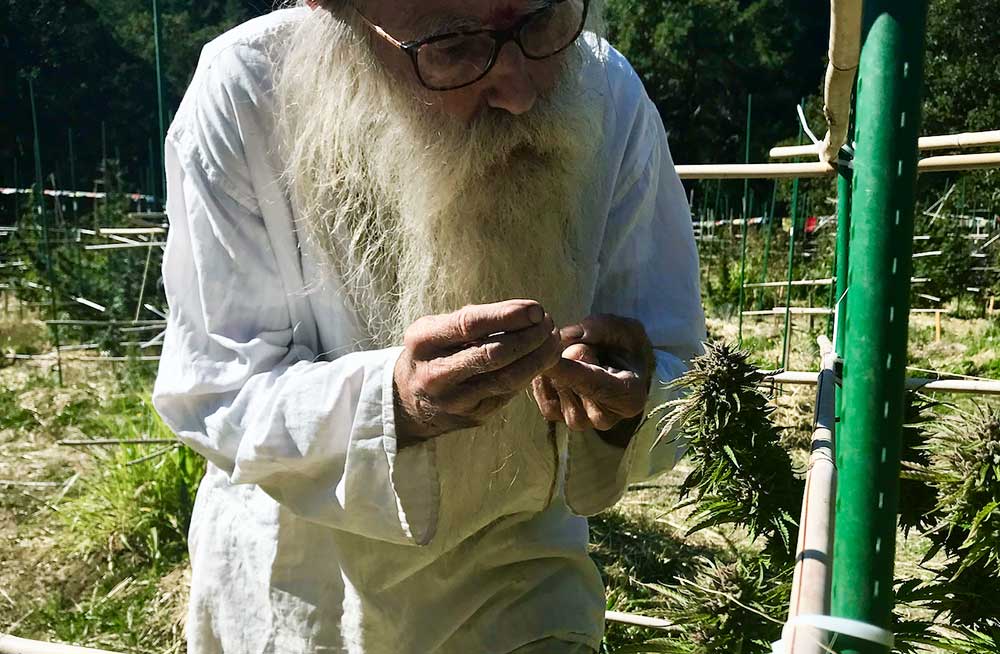
Assuming that you’ve done all the preparations mentioned in the previous article, you now must devise the exact procedure of harvest. This involves several steps:
- Deciding the exact moment to cut each plant.
- Whether to take the whole plant or make two or three cuttings.
- How to transport the cut plants to the drying facility.
- For legal growers in California, how to weigh and record the wet weight immediately after cutting.
- How to keep track of each individual plant and not lose its Metrc tag.
Every farmer has their method of deciding when to cut. We harvest in the dark— very early in the morning—so that we finish that day’s cutting before first light. This ensures the maximum saturation of all the aromatic compounds in the plant, because they off-gas during the day.
When it’s clear that the “girls” are close to harvest, as our crew is yellow leafing, I literally ask each plant individually if it’s ready to come in. With no judgement preferences as to who should be cut next, I use kinesiology (aka muscle testing) to determine who gets cut the next day.
Strong muscle resistance is “Yes” and weak is “No.” I touch a leaf on a plant and ask: “Are you readyto come in tomorrow?” Strong response. Then I ask again: “Do you want to come in tomorrow?” Strong response. Then a third time I ask: “Would you rather stay for a few more days?” Weak response. The answer to the first two inquiries is “Yes!” and to the third is “No!” so I mark that plant for harvest and write down the number of its bed on a list for the morning’s harvest. If on the contrary, the answers are “No,” No,” and “Yes,” then I leave the plant for a later day.
The crew starts at about 5 a.m., donning warm clothes and gloves. With head lamps on and clippers in hand, we take the whole plant, full branch by full branch. That is, unless it’s a very small plant and then we just cut and hang the whole thing. The stalk is left in the bed until springtime.
Harvest Day
Some farmers cut just the top 10 to 12 inches off each branch and leave the rest to mature for another week or two. We don’t do that because it’s difficult to keep track of two cuttings at different times to report to Metrc.
We usually cut about 20 plants on each harvest day and cut for three days in a row. To transport them to the barn we use a 6×12 foot trailer, which I hook up to the car and park next to the garden gate the night prior.
When we arrive at the garden in the morning, we split into two teams. One goes around to the designated plants and cuts away the trellises by clipping the nylon zip ties and pulling away the horizontal bamboo sticks. The other crew picks the plants closest to the garden gate, cuts away the trellises and proceeds to harvest the whole plant. When the first crew is finished cutting away the trellises on the designated 20 plants, they switch over to harvesting also.
Transporting the Harvest

We have 20 clean blue tarps, one for each plant. In the dark, the tarp is laid on the ground next to the chosen plant with the cut branches gently laid on the tarp. When finished, we use carabiners to hook the tarp grommets together to make a large pouch. For legal growers, the carabiner is the place to attach the blue Metrc tag, which must stay with each plant until it becomes a batch.
The tarp is carried to the trailer, and when full, we drive the trailer to the back of the barn, unload and go back for more. To prevent any crushing of the plants, we are careful not to pile them up too high in the trailer.
The carabiner holding the tarp together also easily goes over the hook on the scale for weighing the whole wet plant, required for legal California cultivators. We attach a 4×6 beam between two trees, hang the scale in the middle and use a small ladder to reach the scale. Besides the weight, we note the Metrc number, the bed number, and the cultivar of each plant.
Drying Time

After weighing, the tarp is carried into the barn and the plants are hung on nylon netting hung from the ceiling, and the blue Metrc tag is attached to the netting.
By the time the last plant is in the barn, the sun is just starting to come up and we head to the house for a hearty breakfast of pancakes or cheese omelets. After breakfast, we return to the garden and gather up the bamboo trellis sticks to save for next year.
Stay tuned for the next article about proper drying and curing methods. Happy Harvest!







